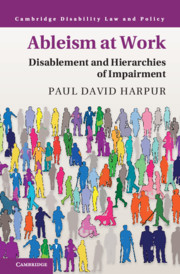Book contents
- Ableism at Work
- Cambridge Disability Law and Policy Series
- Ableism at Work
- Copyright page
- Contents
- Foreword
- Acknowledgements
- 1 Introduction
- 2 International Disability Norms at Work
- 3 The CRPD Committee, Ableism and Hierarchies of Impairment at Work
- 4 Hierarchies of Impairment at Work in the Regulation and Response to Sheltered Work
- 5 The Arbitrary Exclusion of Episodic and Psychosocial Disabilities from Legal Protection
- 6 Ability Apartheid at Work
- 7 Reasonable Accommodations in a Psychosocial Diverse Workplace
- 8 Using Occupational Safety and Health Laws to Promote Psychological Health at Work
- 9 Sanism and Ableism in the Law’s Response to Injured Workers
- 10 Advancing Psychosocial Diversity Using Contract and Unfair Dismissal Laws
- Index
1 - Introduction
Published online by Cambridge University Press: 06 August 2020
- Ableism at Work
- Cambridge Disability Law and Policy Series
- Ableism at Work
- Copyright page
- Contents
- Foreword
- Acknowledgements
- 1 Introduction
- 2 International Disability Norms at Work
- 3 The CRPD Committee, Ableism and Hierarchies of Impairment at Work
- 4 Hierarchies of Impairment at Work in the Regulation and Response to Sheltered Work
- 5 The Arbitrary Exclusion of Episodic and Psychosocial Disabilities from Legal Protection
- 6 Ability Apartheid at Work
- 7 Reasonable Accommodations in a Psychosocial Diverse Workplace
- 8 Using Occupational Safety and Health Laws to Promote Psychological Health at Work
- 9 Sanism and Ableism in the Law’s Response to Injured Workers
- 10 Advancing Psychosocial Diversity Using Contract and Unfair Dismissal Laws
- Index
Summary
The problem of ableism against workers with psychosocial disabilities is not confined to a single jurisdiction and permeates across all jurisdictions analysed in this monograph. The stigma, exclusion and devaluing of worth is not caused by rogue workers or invisible social forces, but by lawmakers who turn bills into statutes and by courts who silently apply ableist norms and discriminate against workers because of their impairment type. This monograph highlights an unacceptable truth: to live with ability diversity is to live with adversity.
Keywords
Information
- Type
- Chapter
- Information
- Ableism at WorkDisablement and Hierarchies of Impairment, pp. 1 - 17Publisher: Cambridge University PressPrint publication year: 2019
